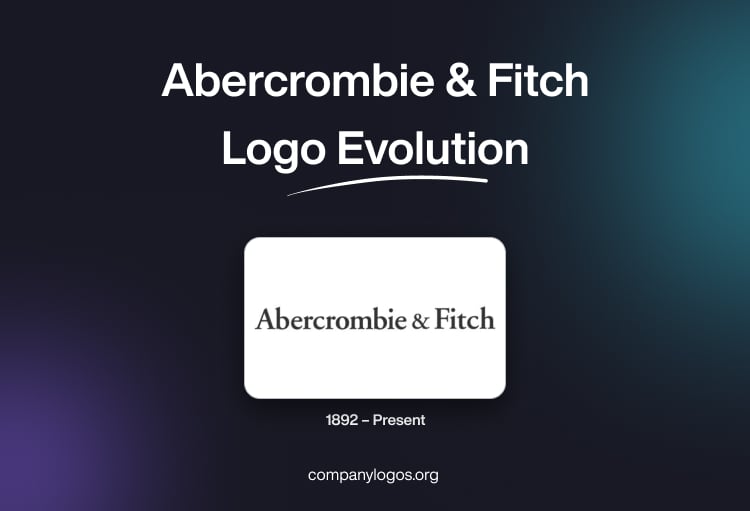
Abercrombie & Fitch, also known as A&F, is an American lifestyle fashion retailer that caters primarily to youth. Based in Ohio, the USA, the company manages four brands, namely, Abercrombie Kids and Hollister. Founded in 1892 by David T. Abercrombie and Ezra Fitch, the brand today operates in over a thousand locations across the globe and has a strong online presence.
It is arguably one of the most famous casual wear brands specialising in high-quality trendy clothing and accessories. The Abercrombie & Fitch logo with a moose hasn’t changed much since it was designed in 1892. The article delves into the various aspects of the brand, especially its logo.
The Genesis of the Abercrombie & Fitch Logo (1892 – Present)
The logo of Abercrombie & Fitch comprises the brand name as the logotype in black or dark grey against a white background. The logo has not changed much since it came into existence in 1892. It is written using Adobe Garamond Bold, which is a classic serif typeface. The use of the font conveys sophistication, tradition, and timelessness. Interestingly, Moose, the animal, has remained the mascot of the brand, as it symbolises confidence, grace, strength, and pride.

The Elements of the Abercrombie & Fitch Logo
Symbol
The moose featured in the emblem is presented in a sleek black silhouette to resemble a shadow from the past. This serves as a reminder of the brand’s unparalleled history, where it stood unrivalled and outshone competitors.
Font
The wordmark in the logo employs the stylish and elegant Adobe Garamond Semibold font. This choice of typography adds a touch of sophistication. Besides, it aligns seamlessly with the brand’s commitment to a refined and timeless aesthetic.
Colour
The predominant colour of the logo is a deep shade of charcoal grey. Initially associated with hiking and tourism, the colour now reflects the urban landscape, which is marked by asphalt roads and towering skyscrapers. The colour grey symbolises stability and constancy and serves as a fitting representation for the logo. Finally, the colour black embodies the essence of power and strength. It signifies the aspirations of the current brand as it strives to uphold the legacy of dominance.
The History of Abercrombie & Fitch
Abercrombie & Fitch, which is also called A&F, boasts a history of transformation and innovation that dates back more than 130 years. The company was originally founded in 1892 by David T. Abercrombie in Manhattan, New York, where he opened a small shop that specialised in high-end sporting, camping, and hunting equipment for elite outdoorsmen. In the early 1900s, Ezra Fitch, a lawyer and outdoor enthusiast who had become a frequent customer, joined the business. This ultimately led to the firm being renamed Abercrombie & Fitch Co.
However, this union did not last long. This was due to the fact that Fitch wanted to broaden the store’s customer base to the general public, while Abercrombie wanted to focus solely on professionals. This divergence of perspectives led Abercrombie to sell his stake to Fitch, who became the sole owner in 1907.
Thereafter, under Fitch’s direction, Abercrombie & Fitch quickly earned a distinguished reputation. For instance, it had a massive 456-page catalogue and moved to more prestigious locations, such as a grand flagship store on Madison Avenue with amenities like a rooftop pool and in-store shooting range. Soon, A&F became an iconic outfitter for explorers, celebrities, and even presidents. Throughout much of the twentieth century, the company thrived by catering to the adventurous spirit of Americans. It provided everything from outdoor apparel to luxury gear.
However, as the retail landscape changed dramatically in the postwar years, the company struggled to adapt. By the 1970s, its focus on expensive luxury goods left it unable to compete with mainstream suburban chains. Attempts to widen its appeal came too late, and Abercrombie & Fitch eventually filed for bankruptcy in 1976. It had to close its famed Madison Avenue store after more than eight decades of operation.
Abercrombie & Fitch was revived when Oshman’s Sporting Goods acquired the brand in 1978. After the acquisition, it operated as a mail-order retailer and opened niche shops. A turning point came in 1988 when Abercrombie & Fitch was sold to The Limited, which repositioned the company as a purveyor of casual luxury apparel and moved its base to Columbus, Ohio.
Through the 1990s and 2000s, under the leadership of CEO Mike Jeffries, the brand reinvented itself as a youth-oriented retailer. It became famous for its aspirational, preppy clothing and provocative advertising. Abercrombie & Fitch diversified by launching lines such as Abercrombie Kids and Hollister Co., which were aimed at younger demographics. The company also explored other concepts like RUEHL No. 925 and Gilly Hicks.
The brand expanded internationally in the 2000s, particularly into Europe and Asia-Pacific markets. Despite its tremendous growth, A&F faced significant criticism and controversy for exclusionary marketing and workplace practices. These resulted in legal challenges and damage to its reputation.
In 2014, after Jeffries left, the company tried to remake its image. It did so by embracing inclusivity and introducing modern store concepts. It focused heavily on digital sales, which surpassed $1 billion for the first time in 2022. Abercrombie & Fitch continues to evolve by placing renewed emphasis on diversity and digital engagement. At the same time, it maintains its heritage as a symbol of American retail reinvention.
Interesting Facts About Abercrombie & Fitch
- Abercrombie & Fitch was originally founded in New York City by David T. Abercrombie. It started as an elite outdoor gear and sporting goods store to cater to hunters, campers, and adventurers.
- Ezra Fitch, who was a wealthy lawyer and one of Abercrombie’s loyal customers, later joined the company and became a partner in 1900.
- The original A&F catered to elite clientele, including Teddy Roosevelt, Ernest Hemingway, Charles Lindbergh, and even Amelia Earhart.
- Its high-end gear was used in Arctic and African expeditions.
- After decades of success, changing consumer tastes and poor business decisions led to financial trouble.
- The original Abercrombie & Fitch closed its doors in 1977 and filed for bankruptcy.
- In 1988, retail conglomerate The Limited, Inc. (now L Brands) acquired the brand and rebranded A&F into a youth-focused fashion retailer to target teens and young adults. This marked the beginning of its transformation into a mall culture icon.
- Under the leadership of CEO Mike Jeffries (1992–2014), A&F became known for its provocative, sexualised ad campaigns. These featured shirtless male models and sensual imagery.
- The brand often faced criticism for objectifying models and promoting exclusionary beauty standards.
- The company was accused of discrimination in its hiring practices. This stemmed from the fact that it favoured a “look policy” for store employees. Also, Jeffries’ controversial statement that A&F only targeted “cool, good-looking people” further fuelled criticism and boycotts.
- Since 2015, under new leadership, Abercrombie & Fitch has undergone a major image overhaul.
- The brand shifted focus to body positivity, inclusivity, and diverse representation in marketing and sizing.
- In 2022, A&F’s dramatic rise and fall were explored in the Netflix documentary “White Hot: The Rise & Fall of Abercrombie & Fitch”, which highlighted its cultural dominance and controversies.
- Abercrombie & Fitch operates over 200 stores worldwide, which include flagships in major cities like New York, London, and Tokyo.
- Abercrombie & Fitch also owns Hollister Co., which is a successful surf-inspired youth brand.
- Abercrombie & Fitch is repositioned as a lifestyle brand for young professionals, with minimalist, casual wear. Its turnaround has received praise from both fashion critics and investors.
Finally
The logo of Abercrombie & Fitch is shown as a robust representation of fashion and exploration. Think of the logo as a time-travelling fashion accessory that moves from its humble beginnings to serve as the icon of a revolution in style. It’s more than just a visual identifier. It is a dynamic chronicle of the journey of Abercrombie & Fitch that shows the twists and turns of an industry in continuous churn.